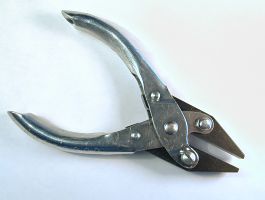
 |
||||
Our physical store Starr Gems Inc. is officially closed. We appreciate your patronage during our last 56 years of business.
Our website order form is currently down while we resituate ourselves. We are currently not taking any orders. Our online presence will resume in spring 2024, along with hopefully the launch of a new website.
Jewelers Beaders and Metalsmith Pliers |
||
 |
Specialty Pliers
Split Ring, Hole Punching, Parallel Jaw, Wire Twisting... |
|
Plier Buying Primer
Your pliers will be among the most frequently used and a important tool investments you will make as a smith or jewelry maker. Our time honored and proven advice to all but the most casual and transient users is to buy and invest in the best quality pliers you can afford. You won't often hear a smith or jeweler lamenting that they wasted their money by buying less than fine, professional quality pliers or other tools!
There is a bewildering array of different types of pliers available to jewelers and smiths for use in a multitude of tasks and applications. However, even once you have determined that your particular application calls for a pair of chain nose pliers for instance, you will find that there are chain nose pliers, and then there are chain nose pliers... You seldom get what you don't pay for, so price is one indication of the overall quality of the tool. Here are some other features to check for and take into account as you perform your own cost/quality calculus in determining which model of a particular type of plier is the right one for you.
Lap Joints Verses Box Joints
 |
 |
| Lap Joint Construction | Box Joint Construction |
One general indicator of the overall quality of a pair of pliers is the type of joint employed to hinge and fasten the two halves of the plier together. While some specialty types such as parallel action or compound ratio pliers employ more complex joints, most types of general use pliers are made using either lap joints or box joints. Very inexpensive, lesser quality lap joint pliers often exhibit significant amounts of side play and looseness even when brand new out of the box. Lap joints also tend to wear faster than box joints, with the result that side play and looseness increases with use over time in all but the heaviest constructed and highest quality lap joint pliers.
Although the box joint design is more difficult and expensive to produce than the lap joint design, it is far superior and results in pliers with exceptional performance and longer life. The side play and looseness in even relatively inexpensive box joint constructed pliers is generally negligible. Box joint constructed pliers also maintain their alignment and precision better through wear and tear and over time than their lap joint counterparts due to their greater effective contact and bearing areas between the halves.
Fit and Finish
 |
 |
| A Typical $3 Finish | A Typical $12 Finish |
Fit and finish on pliers used for smithing and jewelry work concerns the appearance and quality of your work as much or more so as the overall quality and appearance of the pliers themselves. There are some applications for serrated jaw pliers in jewelry making such as securely gripping the end of a wire while pulling it through a draw plate. However, serrations will mar and score soft metals like silver, gold, nickel, copper and brass, and for this reason the jaws of most smithing and jewelry pliers are smooth finished and highly polished. Even otherwise minor defects in the fit and finish on the working areas of the jaws can leave visible marks and blemishes on your work. When you take into account the amount of time you will spend removing and polishing out such tool induced defects on your work, it doesn't take a rock scientist to appreciate it is penny wise and dollars foolish to purchase pliers that are less than excellent in the fit and finish department, particularly so on their work contacting surfaces.
Ergonomic Grips
 |
 |
| Typical PVC Grips | Ergonomic Molded Grips |
PVC grips similar to those shown above are typical of the grips supplied on most smithing and jewelry making pliers. These serve to cushion the underlying metal somewhat and help make the pliers more graspable. This style of grip is employed on pliers of all quality levels. Some pliers feature more ergonomic molded grips. Ergonomic grips serve to increase the contact area between the tool and your hand, providing a more secure and less fatiguing grip than bare metal or typical PVC grips. Ergonomic grips can be a significant feature on pliers that are used for doing repetitive operations for extended periods of time. They are particularly popular with wire and bead workers. Some styles of ergonomic grips feature thumb and finger cups near the hinge to facilitate finer control for more precise and delicate operations.
| 220 West Drachman, Tucson, AZ 85705 Phone: 520.882.8750 ©2000-2010 Reproduction of all content strictly prohibited without written authorization from Starr Gems Inc. |
||||